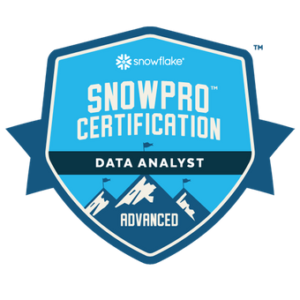 The latest Snowflake advanced certification that was just released is SnowPro Advanced: Data Analyst. Out of all the advanced certifications offered by Snowflake, this one is closest to my professional experience and that’s why I decided to tackle it as my first advanced Snowflake certification.
The latest Snowflake advanced certification that was just released is SnowPro Advanced: Data Analyst. Out of all the advanced certifications offered by Snowflake, this one is closest to my professional experience and that’s why I decided to tackle it as my first advanced Snowflake certification.
Some topics on the exam were relatively easy for me since I have been doing data analysis for decades and SQL is second nature to me. I was able to answer SQL questions without much prior preparation. However, some topics on the exam are very Snowflake-specific that required careful review and study time. These include:
- Snowsight dashboards. I haven’t been using them much, but I had to learn them for the exam. Snowsight dashboards can’t compete in terms of features and functionality as compared to more mature tools such as PowerBI, Tableau, or Cognos, to name a few. But what they offer in their simplicity is the possibility to quickly visualize and summarize data, either for ad-hoc analysis or even to visualize Snowflake usage or performance attributes. Good to know and I have definitely started using them after I learned them for the exam.
- Querying semi-structured data. In addition to structured data that can be queried using standard SQL, increasingly more data sources come in semi-structured format such as JSON. Snowflake has powerful syntax to query semi-structured data that I have been using already, but still needed to have a thorough review before the exam.
- Loading data into Snowflake. Data analysts must be able to quickly load data sets into Snowflake for exploratory analysis. This requires them to know how to work with Snowflake stages, use the COPY command to get data from the stage into a Snowflake table, and be comfortable about getting data out of the cloud onto local storage when needed. This is all very Snowflake-specific functionality that must be studied carefully before taking the exam.
- Snowflake-specific SQL functions. There are so many! Normally, when I perform data analysis and I need some SQL functionality, I just search the Snowflake documentation to find out if there is a function readily available. For the exam, I had to review all the functions listed in the exam study guide and know how to use them. There were quite a few that I wasn’t familiar with previously so it was an excellent opportunity to catch up on what is out there.
After I passed the certification exam, I was interviewed for this article on Snowflake’s website: Get the Data Analyst Competitive Edge with Snowflake’s New Advance Certification. I was quoted as saying: “A component of a data analyst’s role is presenting initial descriptive data analysis through dashboards and reports. Snowflake Dashboards, which is also included in the exam, is a convenient way to do that. The SnowPro Advanced: Data Analyst Certification is an opportunity for all data analysts to demonstrate their expertise and stand out from the crowd.”